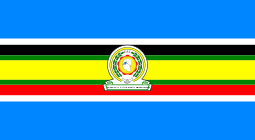East African Federation
Shirikisho la Afrika Mashariki East African Federation |
||||||
|---|---|---|---|---|---|---|
|
||||||
| Motto: "One People One Destiny" | ||||||
| Anthem: EAC Anthem | ||||||
.svg.png) An orthographic projection of the world, highlighting the proposed East African Federation's territory (green).
|
||||||
| Capital | Arusha | |||||
| Largest city | Dar es Salaam | |||||
| Official languages | English | |||||
| Lingua Franca | Swahili | |||||
| Type | Proposed Federation | |||||
| States | ||||||
| Legislature | EALA | |||||
| Establishment | ||||||
| • | East African Community | 7 July 2000 | ||||
| • | East African Federation (established) | |||||
| Area | ||||||
| • | Total | 1,820,664 km2 (17th) 702,962 sq mi |
||||
| • | Water (%) | 5.6 | ||||
| Population | ||||||
| • | 2014 estimate | 153,301,178[1] (10th) | ||||
| • | Density | 84.2/km2 218.1/sq mi |
||||
| GDP (PPP) | 2013 estimate | |||||
| • | Total | US$ 297.791 billion[2] | ||||
| • | Per capita | US$ 1,942 | ||||
| GDP (nominal) | 2013 estimate | |||||
| • | Total | US$ 122.672 billion | ||||
| • | Per capita | US$ 800 | ||||
| Currency | East African shilling | |||||
| Time zone | CAT / EAT (UTC+2 / +3) | |||||
| Website www |
||||||
The East African Federation (Swahili: Shirikisho la Afrika Mashariki) is a proposed political union of the six sovereign states of the East African Community – Burundi, Kenya, Rwanda, South Sudan, Tanzania and Uganda – as a single federated sovereign state.[3] As of 2014, five states (excluding South Sudan) have expressed support for the union, but negotiations continue concerning issues such as the extent of members' sovereignty and timing of implementation.[4]
Features
At 1,820,664 square kilometres (702,962 sq mi), the East African Federation would be the fourth largest country in Africa and 17th largest in the world. With a population of 153,301,178, it would also be the second largest nation in Africa (after Nigeria) and tenth in the world.[1] Its population would be greater than that of Russia, Japan and Mexico, and half that of the United States.[1] a
Swahili would be the lingua franca and the official language would be English. The proposed capital is the Tanzanian city of Arusha, which is close to the Kenyan border. Arusha is the current headquarters of the East African Community.[3]
The union's proposed currency would be the East African shilling, already slated to become the common currency of the five countries in 2018 or later. The GDP (PPP) by (CIA World Factbook) estimate would be US$297.791 billion and be the fifth largest in Africa and 48th[2] largest in the world.
Timeline
The federation of the current East African Community into a single state has been discussed, with early estimates of the founding of the federation in 2013.[5] In 2010, the EAC launched its own common market for goods, labour and capital within the region, with the goal of a common currency by 2013 and full political federation in 2015.[6]
South Sudan was approved for membership of the EAC in March 2016, and acceded in September 2016. It would become the 6th member of the East African Federation.[7] It is unclear how the potential accession of South Sudan to the EAC may affect the timeline for federation or the scope thereof, but given the infrastructure problems that persist in the fledgling country since President Salva Kiir Mayardit cut off oil commerce with Sudan, the South has decided to invest in constructing pipelines that circumvent Sudan's, which it had been using until that time. These new pipelines would extend through Ethiopia to the ports of Djibouti, as well as to the southeast to the coast of Kenya.[8] These collaborations could increase the likelihood of South Sudan joining the East African Federation at some point.[9]
On 14 October 2013, the leaders of Uganda, Kenya, Rwanda and Burundi began a meeting in Kampala intending to draft a constitution for the East African Federation.[10]
As of December 2014, efforts for a full political federation have been pushed back to 2016 or later.[11]
In February 2016, Ugandan President Yoweri Museveni described the union as “the number one target that we should aim at”.[12]
See also
References
- 1 2 3 "The World Factbook". cia.gov. Retrieved 24 July 2016.
- 1 2 "Report for Selected Countries and Subjects". imf.org. Retrieved 24 July 2016.
- 1 2 "Uganda Sunday Vision (2004-11-28): One president for EA by 2010". Sundayvision.co.ug. 2004-11-28. Retrieved 2012-07-15.
- ↑ CHRISTABEL LIGAMI (3 May 2014). "Sharp differences emerge over structure, timing of EAC political federation". The East African. Retrieved 3 Apr 2015.
- ↑ The African Executive. "James Shikwati (2006-06-14) The Benefits of the East Africa Federation to the Youth. The African Executive". Africanexecutive.com. Retrieved 2012-07-15.
- ↑ http://af.reuters.com/article/kenyaNews/idAFLDE65T2AJ201007001?sp=true. Retrieved 7 July 2010. Missing or empty
|title=(help) - ↑ "South Sudan admitted into EAC", Daily Nation, 2 March 2016, reprinted at nation.co.ke, accessed 4 March 2016
- ↑ "South Sudan Oil Transit to Resume, Lamu Project will continue". GroundReport. 2012-03-16. Retrieved 2012-07-15.
- ↑ "EAC prepares to admit South Sudan". theeastafrican.co.ke. Retrieved 24 July 2016.
- ↑ Sudan Tribune. "ST (2013-10-15) Uganda hosts meeting of experts to fast-track political federation of East Africa". SudanTribune.com. Retrieved 2013-10-20.
- ↑ "East Africa: Further Delays for the EAC Political Federation". December 20, 2014. Retrieved May 4, 2015.
- ↑ "Ahead of election, Museveni says he wants to build East African superstate #UgandaDecides". Newsweek. Retrieved 2016-10-22.

